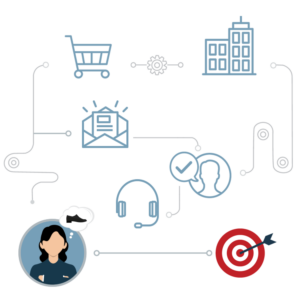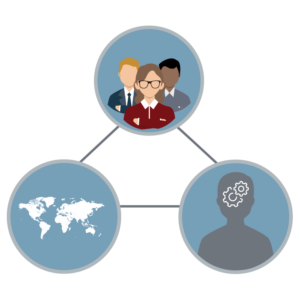

Find out what marketing segmentation is, why you should segment your database, and what your B2B customers expect online. Plus, get started today with 4 ways to segment your B2B database.
What is marketing segmentation (and why should you use it)?
In a nutshell: marketing segmentation is dividing your list of leads and/or customers into smaller, more similar groups for more targeted messaging.
Segmentation is beneficial because advancements in online marketing have made it easier than ever to tailor your marketing messaging to different demographics. Even if you operate in the most specific of niches, there’s still a lot to be won by personalizing your online marketing using segments instead of using the same messaging for all your customers and prospects. Sure, your marketing list has a lot in common — they’re all interested in your specific products or services. But there’s just as much that separates them.
By segmenting your customer groups based on specific characteristics, you create smaller groups with more commonalities. This lets you personalize your marketing plan further, without worrying about alienating part of your audience.
Personalized online marketing: The new normal
Personalization isn’t just a nice-to-have. It’s what your audience has come to expect — regardless of whether you sell to consumers or professional buyers.
Here are a few key stats before we dive into the details:
- 79% of consumers say they are only likely to use a brand’s promotions if they’re tailored to previous interactions
- 88% of marketers experienced a measurable lift in business results thanks to personalization
- Personalization can deliver 5-8x the ROI on marketing spend and lift sales by 10% or more
And the reason that personalization in marketing works is because it takes the needs of your audience into account. And not just general needs — but the needs of the buyer at that time.
With effective marketing personalization, you can show your leads and customers what they need to see when they need to see it in order to help them further along the path to purchase.
And personalization starts with segments.

What data do I use for segmenting customer groups?
There’s no right or wrong answers here — it all depends on your business. The key is to ask yourself: “What affects the way I want to communicate with my customers?”
To help you get started thinking about how to segment your market, here are some types of market segments other companies frequently use.
Geographic segmentation
This is especially interesting if you do business internationally, or in multilingual countries. For instance, U.S. companies could create a segment of Canadian clients and adjust the spelling, or provide information about extra shipping fees.
Demographic segmentation
Segmenting based on demographic information means creating customer groups based on a wide variety of characteristics both in B2B marketing and B2C. This could include:
- Industry
- Company size
- Recipient’s position within the company
For instance, you might want to use different terminology for different industries — or even promote different products entirely. This will make sure that your marketing messaging on your website and in your emails are immediately relevant to the reader

Behavioral segmentation examples
Don’t worry, this doesn’t necessarily require advanced digital systems and a long list of cookies to achieve. Behavioral segmentation could be something as simple as customers who average a certain order amount or haven’t placed an order for over three months. Segments like these let you reward loyal (or especially lucrative) clients with special deals to increase loyalty and re-engage customers who might be at risk of forgetting about you.
Needs segmentation
This type of marketing segmentation is about dividing your leads and customers based on their needs and challenges. You can then offer them super-tailored content and sales messaging to solve their specific problems and move them more quickly along the buying process. Although this type of segmentation can deliver great results, the challenge here is that information about customers’ needs is harder to capture than geographic, demographic or behavioral data — but it can still be done. Learn how to identify and segment based on leads’ needs in this guest post by HubSpot.
Using segments in your Sana Commerce web store
Yes, you can also use customer segmentation to personalize your Sana Commerce web store.
The customer segments’ functionality is native to Sana Commerce. In other words, you don’t need a specific add-on to personalize your web store in this way — it’s built-in. This includes web store segmentation, like personalized on-page content. Using the Sana Commerce MailChimp add-on, you can also leverage segmented email marketing.
Where does this data come from?
Creating your segmented lists directly in your web store is handy, but won’t this create conflicts with your other segments? What about data discrepancies?
Not to worry. All data used is retrieved either from your ERP system — your company’s single source of truth — or Sana Commerce, which is integrated with your ERP. When creating your segments in Sana Commerce, you can choose from the following data:
- Customer information from your ERP system
- Customer web store sales statistics
- Shop account data (last login, account type etc.)
- Shopping cart data (when was it modified, number of items in cart)
With this data, you can create segments as general (“customers from the U.S.”) or specific (“customers from Europe that have spent over €50,000 this year with over 15 items in their shopping cart that haven’t logged in for 2 weeks”).
And that’s just scratching the surface: you’re free to tailor your web store and email marketing personalization to whatever works best for your specific company.




